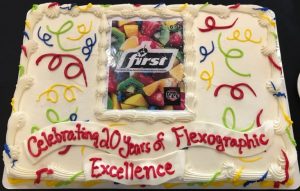
FTA Fall Conference 2017 Review
Opening Sessions
The tally is in, with over 350 attendees, this years FTA Fall Conference 2017 delivered on its promises for "strong technical content." The 3-day conference was held in St. Louis at the Hyatt Regency right next to The Arch.
The conference opened with a historical perspective from industry icons that included: Gerry Vogler, Mark Mazur, Al Bowers, Arleen Neustein, Jeff Randazzo, Eric Ferguson and Lon Robinson. They took us on journey exploring the evolution of the Flexographic Industry over the last 20+ years. Growing from a state where you were considered a "good" printer if your text was legible... to a movement to incorporate and manage Flexo print through a deeper understanding of capabilities and standards (the development of FIRST)... to a state where we are competitive with other print technologies. Today's Flexo printer is not only a high-quality printer, but is also striving for innovative and blended print solutions to allow them to address all their customers needs.
Much of our progress is due to a cooperative effort from professionals throughout our industry to create and update FIRST, which celebrated its 20th birthday!

Technical Innovation Award Winners
Day 2 of the FTA Fall Conference 2017 started with presentations from the three Technical Innovation Award Winners this year.
- Flint Group for EkoCure Ancora Ink
- Mark Andy, Inc for Digital Series Hybrid Press
- Esko for XPS Crystal 5080
Flint Group for EkoCure Ancora Ink
Speaker, Dr. Patrik Gavelin, started with a overview of today's packaging trends:
- Stronger brand recognition
- Purchasing drivers - messages embedded into packaging design
- Shortened design life-cycles
- Promo packaging is more frequent - more short run jobs
Short run jobs are a great fit for UV LED technology due to its lower cost per unit, fast switch on/off, consistent cure with less maintenance and improved sustainability. The challenges are for low migration UV ink and food packaging compliance. Inks need to balance performance considerations with tight restrictions and limitations for LED cure needs and availability for components.
EkoCureTM Ancora
- Food Packaging Compliant
- Excellent Operating Economics
- Health and Environmental Benefits
Mark Andy, Inc for Digital Series Hybrid Press
Speaker, Ray Dickinson discussed the performance highlights for the Digital Series Hybrid Press:
- Digital and flexo
- Customizable
- Configurable
- Reconfigurable
- Upgradeable
- Modular Design
This press combines and leverages strengths of both flexo and UV inkjet delivering economic and capability benefits. Successful implementation of digital incorporates digital workflows and RIP, unique ink and supplies, as well as strong remote and on-site support and training. Ray expressed how he feels digital presses have driven flexo to innovate and improve change-overs and production speeds. Likewise Flexo forced digital to evolve to improve speeds and costs too.
Esko for XPS Crystal 5080
Speaker, Rory Marsoun started with review of exposure technology:
Conventional UVA Tubes
- new tubes should be burned in for 8-10 hours
- tubes should be warmed up for 3-4 minutes prior to back exposure
- tube output is constantly changing and must be measured and compensated for
UVA LED exposure
- light-emitting diode (LED) - energy efficient, cool light, consistent over long time, no warm-up time
- not new - Esko has had inline UV LED (UV1 and UV2) for 10 years (more then 300 systems in field)
The major advantage of UV LED is consistency over time (over 5000 hours) versus continuous degradation over time with bank light source (750 hour life).
XPS Crystal
- can control speed
- can control irradiance
- can control number of passes
- much higher intensity of light the bank light - 300-315 mW (WOW!)
- very simple to use
- simultaneous front and back exposure
- +/- .001" relief consistency
- simple touch screen
- predefined main exposure seeing
- automated back exposure plate test
Ekso released the 5080 at Drupa 2017 and just release the 4835 at LabelExpo Brussels 2018.
Back Exposure Dwell Effect
He wrapped up with a case study of Dwell Effect resolving that this has a direct impact on plate-to-plate consistency. Ultimately findings showed that minimizing the time between back exposure and face exposure improves overall plate quality.
- Shorter dwell = ability to hold more detail on the plate.
- Dots appear to be more stable and uniform in appearance and profile then other flat-top exposures.
For more information, reach out to your local APR Technical Sales Rep for more details or Catherine Haynes at [email protected].
